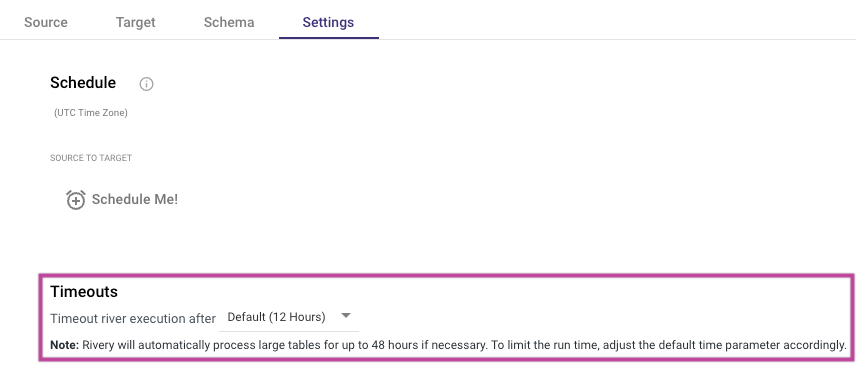- 6 Minutes to read
- Print
- DarkLight
- PDF
Databases Overview
- 6 Minutes to read
- Print
- DarkLight
- PDF
Overview
Rivery enables migrating data from legacy and cloud databases to one of the DWHs we support.
Our database connectors are built with correctness, safety, and security in mind. The term "correctness" refers to the fact that your destination should always be an exact copy of your database source. Rivery should never cause difficulties in your source database, and clients can use a custom file zone to ensure that data does not leave their environment during transit.
We have simple methods to obtain data from databases without needing access to Binary Logs, in addition to connecting with Binary Log capture tools. We can handle more customers and databases thanks to our customizable approach.
Compatible Configurations
The database services listed below are fully compatible with cloud platforms, including Amazon Web Services (AWS), Google Cloud Platform (GCP), and Microsoft Azure. These services can seamlessly integrate into cloud environments to support diverse data workflows and enterprise use cases.
Supported Database Services:
Compatibility of Versions
| Database | Modes | Versions Supported | Support for Managing Schema Drift |
| ElasticSearch | Standard Extraction | Scroll API Version 7.10 |  |
| Indexes API Version 7.10 | |||
| Mapping API Version 7.10 | |||
| MariaDB | Standard Extraction | Versions 10.0 and Above |  |
| System Versioning | |||
| Custom Query | |||
| Microsoft SQL Server | Standard Extraction | All Versions |  |
| Change Data Capture | Sp1 2016 and Above (Standard or Enterprise Editions) | ||
| Change Tracking | All Versions | ||
| MongoDB | Standard Extraction | Versions 3.4 and Above |  |
| Change Streams | Versions 4.0 and Above | ||
| MySQL | Standard Extraction | All Versions |  |
| Change Data Capture | MySQL 5.6 and Above, or MySQL 8.0 and Above | ||
| Oracle | Standard Extraction | Versions 11g and Above |  |
| Change Data Capture | |||
| PostgreSQL | Standard Extraction | All Versions |  |
| Write Ahead Logging (WAL) | Versions 10 and Above | ||
| Redshift | Standard Extraction | All Versions |  |
| Teradata | Standard Extraction | Version 15.10 |  |
| Vertica | Standard Extraction | All Versions |  |
Supported Features:
Parquet File Conversion
It is possible to convert CSV/JSON files to Parquet files when using Amazon S3 as the Target.
Consult our Quick Guide for an illustration of how to do it.
Please keep in mind that while the Quick Guide uses Amazon S3 as a Source, this is possible with any Database and Google Cloud Storage.
Incremental Behavior
Rivery works in millisecond increments, but users can store data in more granular microsecond or nanosecond increments.
When operating incremental runs based on timestamp, it may appear that the most recent record is missing.
Rivery reads three numbers after the dot when there are six, so '2022-08-14 10:26:52.895132' becomes '2022-08-14 10:26:52.895' and the last record is missing from the current run when fetching the data.
Please note that this record will be retrieved in the next run with updated data.
Change Data Capture (CDC) Metadata Fields
CDC is a functionality found in database management systems, allowing for the detection and recording of changes made to data within a database. There are 4 metadata fields commonly used to provide information about the changes made to records.
This section details the automatically appended fields (columns) to the table when employing CDC, including:
- __DELETED
- __TS_MS
- __TRANSACTION_ORDER
- __TRANSACTION_ID
__DELETED
The __DELETED column serves to indicate rows that have been removed from the Source database. In cases of modification, the status is clarified as follows:
- True: indicating that the actual row was deleted from the Source database.
- False: denoting that the row still exists in the Target warehouse but has been updated.
- Null: Indicating that the row remains unchanged in the Target warehouse without any updates.
When a row is deleted from the Source database, it is categorized as a "Hard Delete," indicating that the deletion is irreversible. Our CDC process records this event in the logs table, and the corresponding record appears as a "Soft Delete" in the Target warehouse. This signifies that the most recent version of the row still exists in your Target warehouse. The "Soft Delete" approach in database table management maintains a record of the deleted data, providing the possibility of data recovery if needed, as the deleted rows persist in the Target warehouse.
Please Note:
A Soft Delete retains the record in the table without physically removing it, leading to its continued presence in your Target warehouse and inclusion in backups unless additional steps are taken to exclude it.
__TS_MS
The TS_MS column, short for the TIMESTAMP Milliseconds column, is designed to convey integer values or null entries. Depending on the circumstance, the timestamps within this column are displayed in integer or null. This column serves the purpose of documenting the timing of changes when employing the CDC method.
___TRANSACTION_ORDER
This column indicates the sequence in which the transaction was emitted from the database. It derives its significance from the transaction order within the database log or replication stream. Ensuring that __Transaction_Order is both unique for each transaction and accurately mirrors the actual commit order is crucial.
___TRANSACTION_ID
This serves as a distinct identifier for each transaction generated by the database. The nature of this identifier depends on the database system in use and may be derived from factors such as log position, GTID, or LSN. For instance, in MySQL, the __Transaction_ID field might be assigned the GTID of the transaction, while in PostgreSQL, it could be configured to reflect the LSN.
Here is an example:
Add a Calculated Column
One of the key features of Rivery is the ability to add calculated columns using expressions. This powerful functionality allows the user to customize their output table beyond the limits of the raw metadata extracted from the Source by including expressions, mathematical or string operations, or simple functions to enrich and tailor the output to their use-case.
For more detailed information, please refer to our Targets document.
Limitations of Kafka in Change Data Capture (CDC)
Our CDC implementation uses Kafka for file screening, and it comes with a limitation:
Topics (representing tables and columns) in Kafka cannot be named using characters like underscores (_) or commas (,).
Extended Execution Time for Large Tables
Rivery provides an automatic extension of execution time for processing large datasets, ensuring efficient data loading without manual adjustments. This feature enables Rivers to handle extensive data loads by extending the processing time automatically for up to 48 hours, as needed, to ensure successful completion of data operations.
Dynamic Adjustment Mechanism
Rivery dynamically adjusts the execution time based on table size and row count. When large tables are detected, Rivery automatically activates a long-duration mode, allowing the data processing to continue without user intervention.
Conditions for Extended Execution Time Activation
The extended execution time feature is automatically enabled when the following conditions are met:
- Table Size: The dataset’s table size is greater than or equal to 100 GB.
- Row Count: The dataset contains 50 million or more rows.
- Extraction Method: The extraction method selected is “All.”
- River Mode: The River is configured in either “Multi-tables” or “Legacy River” mode.
User Control and Customization
Users can customize the execution timeout limit in the River’s settings tab to suit specific requirements. By setting a custom timeout, you define the maximum duration allowed for execution. If the custom timeout is reached, the process will terminate according to the set limit, providing control over resource management and operation duration.

Factors Influencing Storage Efficiency and Performance in Databases
The size and storage efficiency of both tables in a database or data source are influenced by factors such as data types, compression, indexes, the number of records or tables, and the configuration of storage, including storage zones. Optimizing these factors is crucial for efficient storage, improved performance, and scalability in a database environment.
In addition to tables, storage in a database is also influenced by similar factors:
- Data Types: Different data types stored in tables occupy varying amounts of storage space.
- Table Size: The size of individual tables depends on the amount of data stored within them.
- Number of Tables: More tables stored in the database lead to increased storage requirements.
- Compression: Compression techniques applied to tables can reduce their storage size.
- Indexes: Similar to tables, indexes created on tables for efficient data retrieval also add to storage requirements.
- Storage Configuration: The configuration of storage, including factors like block size, file system type, and storage zones, impacts storage efficiency, performance, and scalability.
Connection
Click the sections below for details on how to connect to our supported databases:
Note: To view the connectivity options for our databases, please consult the connectivity option documentation.
Mapping Error Message
If you encounter the following message:
The schemas / tables / columns: test_Ñ, משתמשים, خش, C_TAMAÑO_PASTEL and 2 more contains invalid chars, or does not exists, and can not be pulled.View Logs
It indicates that invalid characters are present in the specified tables or columns. As a result, these tables or columns will not be retrieved and will not appear in the mapping.

